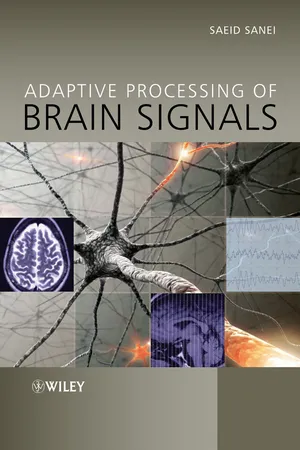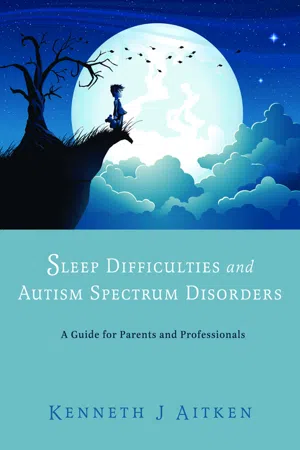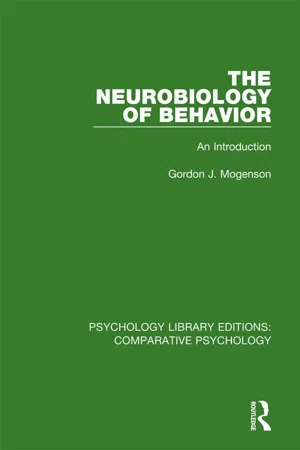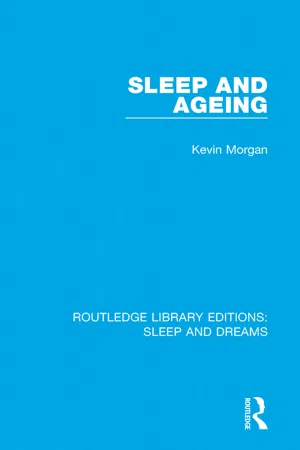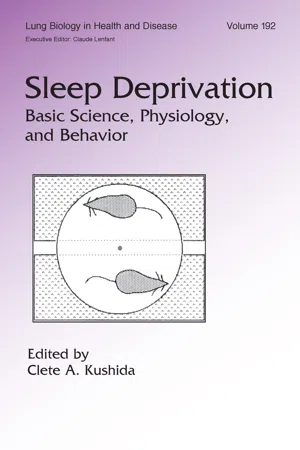Psychology
Sleep
Sleep is a natural, recurring state of reduced consciousness and physical activity. It is essential for overall health and well-being, playing a crucial role in cognitive function, emotional regulation, and physical restoration. The sleep cycle consists of different stages, including rapid eye movement (REM) and non-REM sleep, each serving distinct physiological and psychological functions.
Written by Perlego with AI-assistance
Related key terms
9 Key excerpts on "Sleep"
- eBook - ePub
- William C. Kohler, Peter J. Kurz(Authors)
- 2017(Publication Date)
- Routledge(Publisher)
We still need to Sleep even though we have artificial illumination to counter darkness. Sleep doesn’t occur in response to boredom or mental or physical fatigue. Sleep isn’t necessary to conserve energy. Sleep is not determined by eating or by the resulting stomach vapors that Aristotle and the Greek philosophers thought cooled the heart or blocked the brain’s pores. Nor is Sleep determined by will. And Sleep does not mean the cessation of brain activity – that happens only in animal hibernation.(Maas 1998, 26) So, then, what is Sleep? According to Maas:Rather than being a vast wasteland of monotonous inertness, Sleep is a diverse, complex, multifaceted series of stages that make important contributions to our daytime functioning. The various stages of Sleep we experience each night as our senses disengage from the environment are delineated by significant changes in brain waves, muscle activity, eye movements, body temperature, respiration, heart rate, hormonal activity, and even genital arousal. The overall level of neural activity drops by only 10 percent during Sleep. In fact, the “Sleeping” brain is often significantly more active than the “awake” brain.p.17 (Maas 1998, 27) Far from just “resting,” or being shut down or inactive, even while aSleep the brain is surprisingly active:We now know that various activities of the Sleeping brain play a dramatic role in regulating gastrointestinal, cardiovascular, and immune functions, in energizing the body, and in cognitive processing, including the storing, reorganization, and eventual retrieval of information already in the brain, as well as in the acquisition of new information while awake.(Maas 1998, 27)In addition to attempts to define Sleep, we have always tried to measure this mysterious, cyclical, and essential part of our lives. Recording and measuring the more obvious outward manifestations or episodes seen as associated with Sleep, such as snoring or Sleepwalking, was easy and is frequently reflected in art and literature. - eBook - ePub
- Saeid Sanei(Author)
- 2013(Publication Date)
- Wiley(Publisher)
Sleep has been described by early scientists as a passive condition where the brain is isolated from the rest of the body. Alcmaeon claimed that Sleep is caused by the blood receding from the blood vessels in the skin to the interior parts of the body. Philosopher and scientist Aristotle suggested that while food is being digested, vapors rise from the stomach and penetrate into the head. As the brain cools, the vapors condense, flow downward and then cool the heart which causes Sleep. Some others still claim that toxins that poison the brain cause Sleep [1]. With the discovery of brain waves and later the discovery of the EEG system, the way Sleep was studied changed. EEG enables a researcher to record the detailed electrical activity of the brain during Sleep. Sleep is the state of natural rest observed in humans and animals, and even invertebrates such as fruit fly Drosophila. Lack of Sleep seriously influences our brain's ability to function. With continued lack of sufficient Sleep, the part of the brain that controls language, memory, planning and sense of time is severely affected and the ability of judgement deteriorates. Sleep is an interesting and not perfectly understood physiological phenomenon. The Sleep state has become an important evidence for diagnosing mental disease and psychological abnormality. Sleep is characterized by a reduction in voluntary body movement, decreased reaction to external stimuli, an increased rate of anabolism (the synthesis of cell structures), and a decreased rate of catabolism (the breakdown of cell structures). Sleep is necessary for the life of most creatures. The capability for arousal from Sleep is a protective mechanism and also necessary for health and survival. In terms of physiological changes in the body and particularly changes in the state of the brain, Sleep is different from unconsciousness [2]. However, in manifestation, Sleep is defined as a state of unconsciousness from which a person can be aroused. In this state, the brain is relatively more responsive to internal stimuli than external stimuli. Sleep should be distinguished from coma. Coma is an unconscious state from which a person cannot be aroused.Historically, Sleep was thought to be a passive state. However, Sleep is now known to be a dynamic process, and our brains are active during Sleep. Sleep affects our physical and mental health and the immune system.States of brain activity during Sleep and wakefulness result from different activating and inhibiting forces that are generated within the brain. Neurotransmitters (chemicals involved in nerve signalling) control whether one is aSleep or awake by acting on nerve cells (neurons) in different parts of the brain. Neurons located in the brainstem actively cause Sleep by inhibiting other parts of the brain that keep a person awake.In a human being, it has been demonstrated that the metabolic activity of the brain decreases significantly after 24 hours of sustained wakefulness. Sleep deprivation results in a decrease in body temperature, a decrease in immune system function as measured by white blood cell count (the soldiers of the body), and a decrease in the release of growth hormone. Sleep deprivation can also cause increased heart rate variability [3].Sleep is necessary for the brain to remain healthy. Sleep deprivation makes a person drowsy and unable to concentrate. It also leads to impairment of memory and physical performance and reduced ability to carry out mathematical calculations and other mental tasks. If Sleep deprivation continues, hallucinations and mood swings may develop. Sleep deprivation not only has a major impact on cognitive functioning but also on emotional and physical health. Disorders such as Sleep apnoea which result in excessive daytime Sleepiness have been linked to stress and high blood pressure. Research has also suggested that Sleep loss may increase the risk of obesity because chemicals and hormones that play a key role in controlling appetite and weight gain are released during Sleep. - eBook - ePub
Companion Encyclopedia of Psychology
Volume One
- Andrew M. Colman(Author)
- 2018(Publication Date)
- Routledge(Publisher)
While rest states are seen in all organisms, Sleep as we define and measure it in warm-blooded mammals has many significant features not seen in lower animals. Thus, although the reptiles and birds have both high-voltage and low-frequency electroencephalogram (EEG) patterns and diminished responsiveness (as in mammalian NREM Sleep), they evince no REM phase despite having all the brain-stem structures used by mammals to activate their brains periodically in Sleep. The only exceptions are birds, who show brief REM episodes in the first few days after hatching. They lose this Sleep state as they mature, thus paralleling the dramatic decline in Sleep-and especially REM-that occurs in the early development of all young mammals (Roffwarg, Muzio, & Dement 1966). Amphibians have none of the Sleep features of mammals and, unless their temperature falls, they remain constantly alert even when immobile and relaxed for long periods of time.I begin this chapter by defining the states of waking, NREM, and REM Sleep and their behavioural, electrographic, and psychological activity changes that allow for the investigation of the functional implications of Sleep and dreaming. I shall then describe the most recent findings regarding the functional roles of the different states of the brain-mind, not only because they are exciting in their novelty, but also because they strongly support some of our common-sense notions about the importance of Sleep. Whatever ultimately stands as the truth of the matter, it is already clear that Sleep is a global organismic phenomenon, and its study can integrate in an illuminating way many domains of behavioural and psychological science with neurobiology.Sleep
Behavioural and psychological definition of Sleep
Sleep is a behavioural state of homeothermic (warm-blooded) vertebrate mammals defined by characteristic changes in posture; raised sensory thresholds; and distinctive electrographic signs. Sleep is usually associated with a marked diminution of motor activity and with the assumption of recumbent postures. Typically the eyes close and the somatic musculature becomes relaxed. As Sleep deepens, threshold to external stimulation increases and animals become progressively more unresponsive to external stimuli (see Figure 1 ).Figure 1 - eBook - ePub
Sleeping, Dreaming, and Dying
An Exploration of Consciousness
- Dalai Lama, B. Alan Wallace, Thupten Jinpa, Francisco J Varela(Authors)
- 2002(Publication Date)
- Wisdom Publications(Publisher)
“Why is this realization particularly relevant in understanding the neuroscience of Sleep? All research on Sleep inevitably deals with radical changes in one’s identity, one’s self, or one’s consciousness. When you go to Sleep, all of a sudden you are not there. This automatically raises the elusive notion of self, from which some neuroscientists would rather shy away, not to mention the whole mysterious issue of dreaming.Early Ideas
“Let’s move on to the specifics of the neuroscience of Sleep. Looking historically at the research on Sleep, we see that the main discoveries have all disproved the view that Sleep is passive. Neuroscience started off with the traditional idea that Sleep is like switching off the lights of the house, and that human beings left alone with nothing to do will fall aSleep.“Advances in research very quickly made it clear that Sleep is an active phenomenon. It is a state of consciousness with its own laws. It was Sigmund Freud who first articulated that Sleep is an active process. Although he started as a neuroscientist, Freud moved in a different direction, toward psychology, about which we will hear later this week. Around 1900, the first researchers tried to define Sleep physiologically. Around 1920, a French scientist named Henri Pieron expressed the dominant modern view of Sleep as having three characteristics. First, it is a periodic biological necessity. Second, it has its own internally produced rhythm. Third, it is characterized by an absence of motor and sensory functioning.“I’ll skip several other milestones and jump ahead to a discovery that is of great relevance for us here. In 1957, a group of American researchers described what is known today as the state of REM Sleep. REM stands for rapid eye movement. This discovery marks the beginning of the mainstream research that continues very actively today.The Basics of the EEG
“Between 1900 and 1957, neuroscience had come to understand in depth the electrical phenomena of the brain, which made the REM discovery possible. We are going to take a detour now in the presentation, leaving Sleep aside for a moment, and speak about recording electricity from the human brain by means of the electroencephalogram (EEG). For half a century, the EEG has been the main noninvasive method of investigating human brain activity. (Recent methods of brain imaging constitute a very important alternative and complement, but let us stay with EEG for the time being.) Without some understanding of the techniques and biology of the EEG, we cannot appreciate the neurobiology of Sleep. - eBook - ePub
Sleep Difficulties and Autism Spectrum Disorders
A Guide for Parents and Professionals
- Kenneth Aitken(Author)
- 2012(Publication Date)
- Jessica Kingsley Publishers(Publisher)
The similarities in the underpinning biological processes, across the animal kingdom, are allowing significant developments in our understanding of human Sleep to be made through the study of its development in other ‘model organisms’ such as Drosophila melanogaster (the fruit fly) and Danio rerio (the zebrafish) (Hendricks, Sehgal and Pack 2000). In addition to Sleep–wake cycle issues, mood disorders including unipolar depression and seasonal affective disorder are typically due to abnormalities of the circadian system (McClung 2007; Monteleone and Maj 2008). There is a growing body of evidence that circadian abnormalities are seen in a large proportion of individuals with ASDs (Glickman 2010). Methods for the reliable assessment of human circadian rhythms are now available and in use (see Hofstra and de Weerd 2008). Variations in cognitive ability follow a circadian pattern and are affected both by endogenous circadian clocks and external factors that vary the amount and timing of actual Sleep (Kyriacou and Hastings 2010). W HAT IS Sleep? A useful starting point in understanding and unravelling Sleep problems is trying to get a basic idea of what Sleep is, why we might do it and what it might be for. We should start by defining what we mean by Sleep. There are many definitions to choose from. Here is a selection: Sleep is a reversible condition of reduced responsiveness usually associated with immobility. (Cirelli and Tononi 2008, p.1605) …Sleep is that golden chain that ties health and our bodies together. (Thomas Dekker, The Gull’s Hornbook 1609) Sleep is the interest we have to pay on the capital which is called in at death; and the higher the rate of interest and the more regularly it is paid, the further the date of redemption is postponed. (Arthur Schopenhauer) Sleep that knits up the ravelled sleave of care, the death of each day’s life, sore labour’s bath, balm of hurt minds, great nature’s second course, chief nourisher in life’s feast - eBook - ePub
The Neurobiology of Behavior
An Introduction
- Gordon J. Mogenson(Author)
- 2018(Publication Date)
- Routledge(Publisher)
7Sleep and Waking
Like most humans, you spend about one-third of your life aSleep. Some animals, such as the cat, Sleep 75–80% of the time, and certain animals such as the bear, Sleep most of the time—for weeks or months during a period of hibernation. Sleep alternates with waking in a regular manner, and Sleep-waking is one of the most important and prominent biological rhythms. Sleep has biological significance in the sense that we neither feel well nor perform well when lacking Sleep and also in the sense that it competes with ingestive, agressive, and other behaviors. Although many behaviors are absent or occur only infrequently during Sleep, Sleep is not the absence of behavior; rather, as suggested by several authors in this field, Sleep is a distinctive kind of behavior. Considered from the ethological point of view, for example, Sleep is the final consummatory phase of a complex instinctive behavioral sequence (Moruzzi, 1969). The drowsiness or appetitive phase that precedes Sleep frequently includes instinctive or species-specific patterns of behavior (e.g., returning to the home territory; building a nest or shelter). Moruzzi (1969) points out that Sleep may occur in a specific territory (“the area of maximum security where the young are born and cared for”), and in some species “a typical social pattern is closely associated with Sleep [p. 182].”Our main interest in this chapter is with the neural substrates of Sleep and waking, but we begin, as in the other chapters, by first considering the characteristics of Sleep and the factors that initiate and influence Sleep. There has been a great deal of activity in the field of Sleep research in recent years that has led to important empirical findings and to changes in our views about the neural mechanisms. One of the major developments discussed in later sections is a change from the view that Sleep is a passive process—the absence of waking—to the view that Sleep is an active process; in other words, there is a neural mechanism in the brain that produces Sleep. - eBook - ePub
- Kevin Morgan(Author)
- 2017(Publication Date)
- Routledge(Publisher)
This improved understanding owes much to two developments which ultimately revolutionised the study of Sleep. The first of these concerned the way in which Sleep was quantified or measured, while the second concerned the way in which these measurements were subsequently interpreted. The significance of these two developments are probably best understood in a historical context.The Measurement of Sleep
Traditionally, interest in Sleep has been related to interest in dreams. It is unsurprising, therefore, that in the late nineteenth century interest in the nature of Sleep received an indirect stimulus from the psychoanalytical movement which, under Freud, held dreams to be the rational organisation of unconscious thoughts, interpretable through analysis, and deserving of much attention. Psychoanalysts not only brought their attention to the study of dreams, they also brought their method — science. By the early years of the twentieth century what might be identified as Sleep research consisted of the disparate but occasionally overlapping interests of physiologists, psychologists, psychiatrists, and others. Sleep is not a single event but at least to the researcher is myriad coordinated events and processes, any one of which may be measured and analysed. Aspects of the Sleeping state selected for measurement reflected more or less the background of the researcher. Thus, while physiologists measured variations in blood pressure, temperature, heart rate and blood chemistry etc., those with a psychological bent showed a preference for the behavioural nature of Sleep, for example its depth, its duration, or the effects of Sleep loss on the mental state.By the early 1930s considerable information had been accumulated concerning biological events during Sleep, the periodicity or time schedule of Sleep, and also the physiological and psychological consequences of Sleep deprivation. Despite the large amount of information produced it was clear to some researchers that something was missing. Simply put, between Sleep as described by the scientists, and Sleep as experienced by the individual, there existed a credibility gap. At the level of human experience, Sleep is not assessed in terms of fluctuations in temperature, or changes in systolic blood pressure. Rather, we tend to consider Sleep in terms of its duration, its depth, its restorative quality and so on. What was conspicuously absent from Sleep research at this time was an adequate means for relating the objectively measured processes of Sleeping to the personal experience of Sleep. What was required was a measurement, or a cluster of measurements which reflected relevant physiological change, and also correlated with Sleeping behaviour. - Nancy Fenton, Jessica Flitter(Authors)
- 2015(Publication Date)
- Research & Education Association(Publisher)
Figure 7.1 Typical Sleep PatternsThe average Sleep cycle lasts approximately 90 minutes and is repeated four to six times per night. Throughout the night the amount of time spent in the REM stage increases and the amount of time spent in stage 4 Sleep decreases. See Figure 7.1.Sleep Deprivation and Functions of SleepAlthough a few individuals have stayed awake for up to ten days, most people find the need to Sleep to be one of the most overpowering urges they have ever experienced. Sleep deprivation studies provide psychologists with an opportunity to better understand the importance of Sleep and how deprivation affects physical and cognitive processes. Longterm extreme Sleep deprivation has been associated with the development of psychotic symptoms, including hallucinations and delusions in some individuals. Chronic Sleep deprivation tends to reduce attention levels, especially for repetitive tasks, reduce reaction time, increase negative emotions, reduce immunity, and increase weight gain. Most Sleep-deprived individuals begin to take microSleeps , or naps that last only a few seconds. Individuals are often not aware that they are having these short lapses in consciousness, which can be very dangerous because they may lead to car accidents.What is the purpose of Sleep? Several different theories have been proposed regarding the function of Sleep. One theory states that Sleep was naturally selected to help keep animals and humans out of harm’s way and allow for the conservation of energy. Another theory for Sleep’s function is that it gives the body a chance to rest and repair itself. Also, because of the fact that growth hormones are released mainly during Sleep stages 4 and 3, it is possible that Sleep plays a critical role in the growth process. Finally, recent research has demonstrated that Sleep may be necessary in order for the brain to consolidate new memories and for learning to occur. Individuals who slept not long after learning new material were better able to retain and retrieve the information they learned. Furthermore, participants who slept after learning were more successful at evaluating the information they learned, resulting in the ability to make more innovative connections. Participants in the study who did not Sleep after exposure to the new material did not have as much success. In variations of this study, it was discovered that, regardless of the time of day during which the experiment was done, participants who slept were better able to recall the new information.- eBook - ePub
Sleep Deprivation
Basic Science, Physiology and Behavior
- Clete A. Kushida(Author)
- 2004(Publication Date)
- CRC Press(Publisher)
2 History of Sleep DeprivationWILLIAM C. DEMENT, CLETE A. KUSHIDA, AND JUDY CHANGStanford University, Stanford, California, U.S.A.I. Introduction
Why do we Sleep? What happens when we Sleep? Do we need to Sleep? People have pondered such questions about Sleep since ancient times. Aristotle addressed the issue of Sleep in his essay “On Sleep and Sleeplessness,” in which he wrote that Sleep and waking originate in the heart and are regulated by a primary sense organ. He proposed that after food is eaten, evaporation from it rises to the brain, condenses, and sinks down to the heart, causing Sleep (1 ).Even before Aristotle, it is likely that people realized there were consequences if they did not Sleep. In ancient times such consequences may not have been labeled under the single word “Sleepy.” Over the years, we have learned that there are wide-ranging complaints about Sleep loss and substantial individual differences. The symptoms of Sleep loss may include tiredness, nausea, headache, burning eyes, blurred vision, joint pain, and diminished libido. Because of the general misery of these symptoms, it was an almost inevitable assumption that the purpose of Sleep was to get rid of a hypnotoxin or fatigue product, which accumulated during wakefulness and, if allowed to continue accumulating, resulted in these symptoms.Many people considered Sleep to represent a total shutdown of brain function along with marked quiescence of the body; a state of near death. Carried to the extreme, Sleep was viewed as a short death and death as a long Sleep. The phenomenon of dreaming was sometimes conceptualized along these lines with the notion that some extracorporeal being or soul of the dreamer left the body temporarily at night and left the body permanently at death. There already was a large body of literature on the phenomenon of dreaming, elegantly reviewed by Freud in his influential book “The Interpretation of Dreams” (2
Learn about this page
Index pages curate the most relevant extracts from our library of academic textbooks. They’ve been created using an in-house natural language model (NLM), each adding context and meaning to key research topics.

